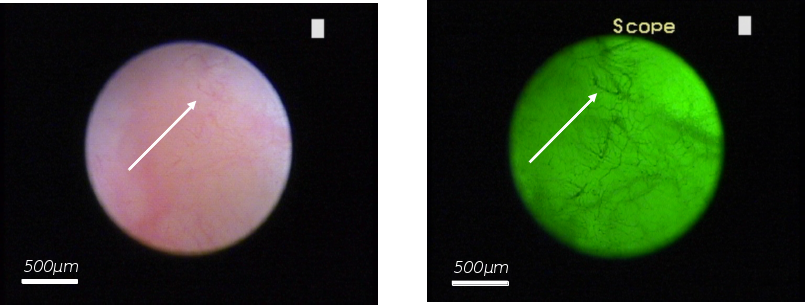Characterization of superficial cancers by high magnification endoscopy
Cancer detection by endoscopic fluorescence imaging (EFI) is mostly used in the bladder and the tracheo-bronchial tree to localize, delineate and/or monitor the resection of non-muscle invasive bladder cancer, or early stage carcinoma, respectively. The tumor/normal tissues optical contrast is produced by the native tissue autofluorescence in the tracheo-bronchial tree. In the bladder, this contrast is induced by the selective production and accumulation of fluorescing porphyrins (including protoporphyrin IX (PpIX)) in cancerous tissues after the instillation of Hexvix®.
Although the sensitivity of these procedures is very high, their specificity is somewhat limited by the occurrence of fluorescence false positive sites. We study magnification endoscopy to characterize the superficial vascularization of the fluorescence positive sites to discriminate cancerous from non-cancerous tissues. More precisely, we aim at identifying the optimal spectral designs, magnification rates, and image features to characterize the investigated tissues. Our preliminary results allowed us to establish a classification based on the observed vascular patterns.

Vessel visualization by white vs. backscattered green light
Tissue characterization by fluorescence imaging
Assessment of tissue oxygenation and metabolic activity by steady-state and time-resolved luminescence imaging.
The general objective of this project is to develop new techniques to produce images of the oxygenation and metabolic activity of biological tissues by steady-state and time-resolved luminescence imaging of porphyrins produced endogenously. This approach will provide useful fundamental information regarding the metabolic mechanisms related to oxygen delivery and consumption, as well as the endogenous production of protoporphyrin IX, an approved luminescent photosensitizer. Medical applications of this approach will allow us to delineate, monitor and individualize therapies of dermatological conditions, such as actinic keratosis (AK) and Martorell’s ulcer.